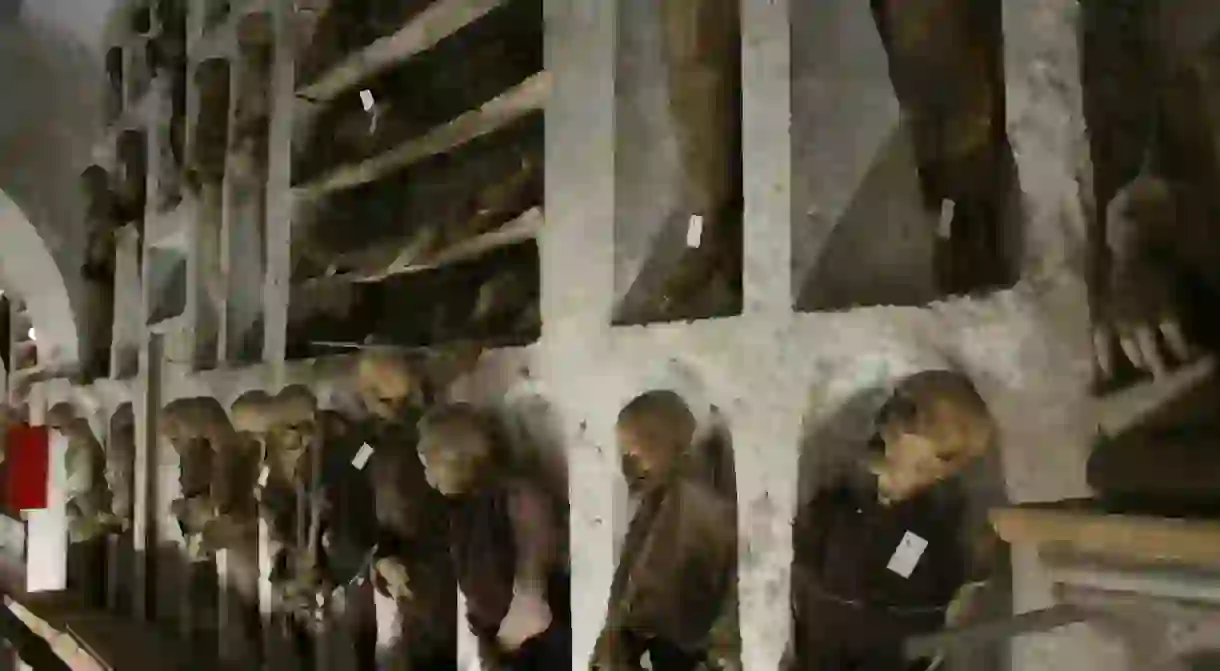The Story Behind Capuchin Monastery Catacombs

One of the most unusual and admittedly ghoulish sites in Palermo has to be the Capuchin Monastery Catacombs. If you are looking for a conversation starter for your next dinner party, schedule a visit here. If you dare.
In the 1600s, the cemetery overseen by the Capuchin monks was full. Instead of expanding the traditional burial grounds when Brother Silvestro of Gubbio died, the monks decided to excavate the crypts below the cemetery and mummified him so they could continue to be and pray with him. It is this monk who greets you at the entrance to the catacombs all these hundreds of years later.
After a few centuries of this being a practice only for the Capuchin monks, they decided to expand and offer this type of burial to residents of Palermo who could afford it. Preservation methods for the bodies had been perfected by the monks over the years, such as a combination of the natural atmosphere of the catacombs and a series of drying rooms with a ceramic piped draining system began the process. The bodies were then bathed in a vinegar solution and stuffed with hay. Families provided clothing to dress their loved ones and frequently came to visit with them. This was a costly endeavor, a sign of prestige and one that only the wealthiest families in Palermo could afford due to the expense of the upkeep. Sometimes that included regular costume changes.
The warren of rooms are divided into separate sections. Priests are dressed in their clerical vestments and military and public officials still wear their dress uniforms. There are dedicated rooms for virgins, women, men, children and infants. Some bodies are embalmed and displayed in glass caskets while others are hung in a standing position from the walls. Many of the bodies are now protected by wire cages because people were taking bones as macabre souvenirs.
One of the most famous and heartbreaking residents of the catacombs is Rosalia Lombardo. Rosalia was just two years old when she died tragically of pneumonia. She appears dressed in a party dress, as if she is just sleeping in a glass coffin, her body perfectly preserved with a slight purple cast. The embalming technique was a mystery until Italian biological anthropologist, Dario Piombino-Mascali, who works with the Institute for Mummies and the famous Iceman in Bolzano, tracked down living relatives of the embalmer. Alfredo Salafia was a Sicilian taxidermist and embalmer who died in 1933. His handwritten notes outline a chemical formula of formalin, zinc salts, alcohol, salicylic acid and glycerin that account for the incredible condition of the sweet lost Rosalia.
The catacombs are said to hold 8,000 bodies but the number is probably closer to 2,000, some of them quite notable. Rumor has it that celebrated writer of the novel The Leopard, Giuseppe Tomasi di Lampedusa is here, but his body is actually buried at the nearby cemetery. There are members of the Sicilian aristocracy, lawyers, doctors, artists and even the son of a Tunisian king inside, their preserved bodies dressed in clothes they wore in life resting for eternity below the streets of Palermo.













